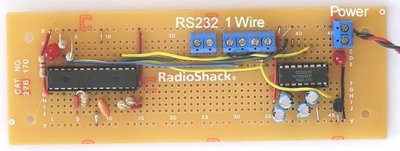WX175 Construction Notes
This supplements the designers construction instructions.
I prefer to build a bit and then test everything to ensure I have not messed up. When things do go wrong step back take a short break. Compare your work to the provided diagrams. look for solder bridges or misplaced wires. That will solve more then 90% of the problems.
For this project first get hyterminal working with a loopback setup. Then build the RS232 setion of the project and get it working in a loopback manner. The build the processor section and get it working. Then connect the processor section to the RS232 section.
Step1: Setup hyperterminal and the serial port cable.
First grab a PC (an old one if you are new to this) and run hyperterminal. Create a connection that uses port1 (or port2) with None-8-1 and no flow control (as described by designers docs). Attach a RS232 cable to that port. Get a DB9 connector of the sex that plugs in the free end of your cable. Jumper pins 2 and 3 together on the DB9. With the jumpered DB9 installed you should see the characters you type echo on the screen. Remove the DB9 and they should stop echoing. Once this works you are ready to start building the kit. Note: be careful not to short pins 2 or 3 to (ground) pin 5. It may blow the RS232 level shifter on your PC.
Remove the jumper from pins 2 and 3 of the DB9.
Step 2: Build the RS232 section.
Start with the max232 chip. Add the capacitors and the lines to your DB9 connector. Then jumper between pins 11 and 12 on the max232 chip. This will create a loop such that any characters recieved by the max232 are transmitted back to the PC. Hook the DB9 to a PC serial port. Run hyperterminal as in step1. If you have everything right you will see the characters you type echoed on the screen. Then turn off the power to the max232 and the characters should stop echoing.
Remove the jumper from pins 11 and 12.
At this point we know that the RS232 section works.
Step 3: Build the processor section.
Add the processor (or socket), resonator, activity LED, 6 pullup resistors, and the 4 lines for power and ground. Insert the processor if socketed. Apply power, the activity LED should blink every few seconds to indicate the processor is running.
Step 4: Connect the processor to the max232 chip.
Connect the processor to the max232 chip as indicated in the diagram provided with the kit. If all is well you can send command to the processor and see responses as in kit instructions. Not much can go gone wrong. You tested the RS232 section and only made 4 more connections. Check them if the processor does not respond.
Step5: Connect I/O
From here on in you are on your own. Hook up a few lines and then test to see if you 'broke anything' and if the new connections work as expected. Maybe start by adding the lines for the 1 wire runs. Then hook up a few temperature sensors.
Good Luck.







